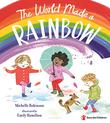Masks or no masks? These days there isn’t much ambiguity. Public health officials are agreed that the wearing of masks significantly restricts the spread of coronavirus. Elmo knows it: Heroes Wear Masks.
 But there is at least one niche of the population for whom the question “Masks or no masks?” has no easy answer but plenty of urgency: children’s-book illustrators with contracts for Fall 2021 and Spring 2022. Will mask usage still be mandated when the pub date finally rolls around? Even if it’s not mandated, will it have become commonplace, as it did in East Asia following the SARS outbreak in 2002? Will preschoolers and early-elementary children in the near future regard maskless characters with the same sense of unreality as they might characters riding bikes without helmets?
But there is at least one niche of the population for whom the question “Masks or no masks?” has no easy answer but plenty of urgency: children’s-book illustrators with contracts for Fall 2021 and Spring 2022. Will mask usage still be mandated when the pub date finally rolls around? Even if it’s not mandated, will it have become commonplace, as it did in East Asia following the SARS outbreak in 2002? Will preschoolers and early-elementary children in the near future regard maskless characters with the same sense of unreality as they might characters riding bikes without helmets?
I’ve noticed commentators using, with greater or lesser degrees of irony, the post-apocalyptic phrase “the Before Times” to describe life back in January 2020—those golden days when we could cross state lines without test or quarantine, when we could go to the movies and sit next to strangers without thinking twice, when we could go to the supermarket with our reusable bags and without following directional arrows. When we hadn’t mourned the passing of over 200,000 Americans and going on almost 1 million worldwide as of this writing. And when we didn’t have to ask ourselves, “Do I have my mask?” whenever we leave our homes.
 For a small child, however, the before times are a lot further away, relative to their overall years, than they are for adults. For my nephew who turned 4 this summer, the mask-wearing era amounts to roughly 20% of his post-toddlerhood life. Those children starting kindergarten in 2020 with any in-person attendance at all know school only from behind a mask. A young friend of mine agonized about sending his son under these conditions. “I just want him to have a normal school experience,” he lamented. “To this year’s kindergarteners,” I reminded him, “masks are normal.”
For a small child, however, the before times are a lot further away, relative to their overall years, than they are for adults. For my nephew who turned 4 this summer, the mask-wearing era amounts to roughly 20% of his post-toddlerhood life. Those children starting kindergarten in 2020 with any in-person attendance at all know school only from behind a mask. A young friend of mine agonized about sending his son under these conditions. “I just want him to have a normal school experience,” he lamented. “To this year’s kindergarteners,” I reminded him, “masks are normal.”
There has been a raft of pandemic-themed books out this year designed to help children through it. In addition to the aforementioned Elmo story by Lillian Jane and illustrated by Ernie Kwiat (Sourcebooks Wonderland, Sept. 15), we’ve seen Coronavirus, by Elizabeth Jenner, Kate Wilson, and Nia Roberts and illustrated by Axel Scheffler (Nosy Crow/Candlewick, April 14), Share Your Rainbow, by 18 different illustrators and with an introduction by R.J. Palacio (Random House, July 7); and The World Made a Rainbow, by Michelle Robinson and illustrated by Emily Hamilton (Bloomsbury, Oct. 13). Librarian Patricia Sarles (a sometime Kirkus reviewer) compiled a prodigious bibliography of children’s books from around the world that in some fashion address the pandemic. (Interestingly, none of these titles depict characters in masks. Coronavirus originated in the U.K. at a time when masks were discouraged; how much longing for the before times versus a desire for sales to those who refuse masks influenced the choices in the latter two is anyone’s guess.) They vary in quality and specificity, but almost all stress that the pandemic restrictions are temporary and look forward to a return to the before times.
 But what if there is no return or if it doesn’t arrive any time soon?
But what if there is no return or if it doesn’t arrive any time soon?
What if, as professor of pediatrics Aaron E. Carroll suggested recently in the New York Times, a vaccine does not result in an immediate return to normalcy and restrictions persist far longer than Americans like to wait? What if, as Carroll urges, mask usage becomes normalized?
Obviously, these questions must be occurring to writers as well as illustrators, but it is illustrators who so often strive to create in their books a visual reflection of their readers’ reality. And they need to decide now or very soon how they will anticipate that reality as they work on books set in a near-future here and now about sharing, friendship, school, and any number of other quotidian topics.
Masks or no masks?
Vicky Smith is a young readers’ editor.



































